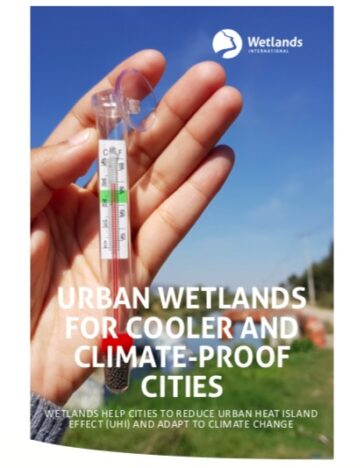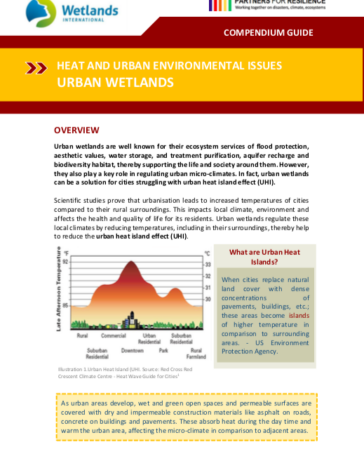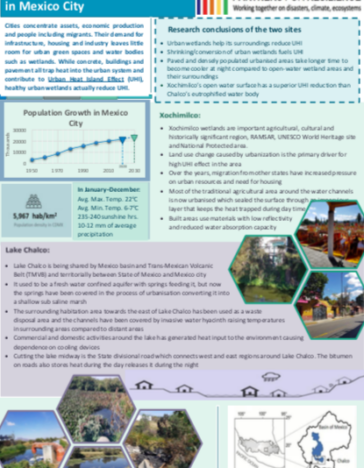Urban Wetlands for Cooler Cities
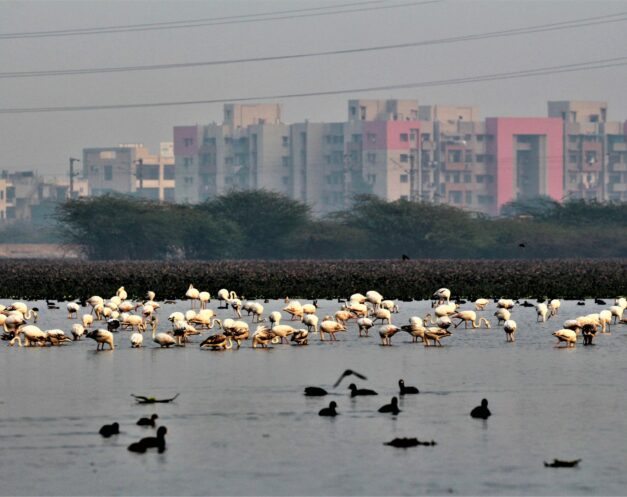
In an already urbanised world, cities are suffering from Urban Heat Island Effect, (UHI) – higher temperatures in built up areas – due to reduced green space, increased paved surfaces and more frequent heat waves stemming from climate change. Urban wetlands, especially in a healthy state, with high biodiversity values and ecosystem functioning, help to cool cities and adapt to climate change. We therefore call upon local governments to safeguard urban wetlands by integrating them into urban planning and investing in restoration (and in some cases construction of) urban wetlands for local climate action.
What is the Urban Heat Island (UHI) effect?
Urban Heat Island (UHI) is an effect in urban areas where temperature within the urban centre is relatively higher than its surrounding areas, creating a city-specific phenomenon. Cool nights are crucial for human health to achieve recovery from heat exposure. Increased exposure to heat also causes higher energy consumption and leads to more emissions. Urban Heat Islands have deadly effects on people’s health, as those of age 65+ are more likely to die from heat-related cardiovascular disease, respiratory illness or diabetes (EPA); in the year 2003 alone heat waves caused up to 70,000 fatalities in central and western Europe (European Climate Adaptation Platform Climate-ADAPT).
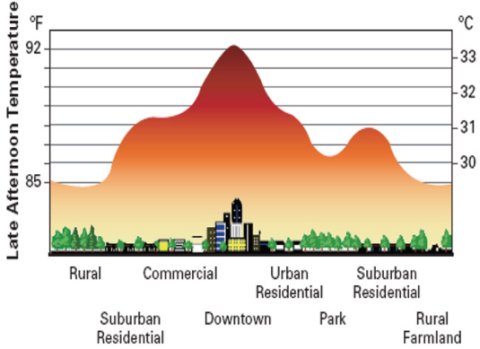
How do healthy urban wetlands reduce UHI?
Water has high specific heat capacity which also helps to regulate the rate at which air changes temperature. This means, that water will absorb more heat before it begins to get warmer and subsequently evaporates. Furthermore, water bodies also reflect solar radiation, especially at a low sun angle. Paved cities without water bodies remain warm and take longer time to cool down than the cities with water bodies, such as wetlands. Especially healthy wetlands with open water surfaces provide this cooling effect. Urban wetlands that suffer from degradation caused by contamination, affected hydrology and become eutrophied, lose part of their cooling service. These wetlands need to be restored.
Evidence from around the world
A study conducted by Wetlands International in 2019-2020 in the Mexico City of the two major urban wetlands of lake Chalco and Xochimilco UNESCO World Heritage Site and protected area, also recorded higher temperatures in the inland city areas compared to the wetland adjacent areas. Lake Chalco which is more eutrophied, recorded 4°C lower temperature than Xochimilco with partial open water bodies. Xochimilco recorded 8°C lower temperatures than the rest of the city. An average increase of ± 2°C was measured for 35 meter intervals further away from the wetlands deeper into the fully paved and built-up city.
A study conducted in Pearl River Delta Metropolitan Region (PRD) China, shows that natural cooling processes of the assessed blue spaces like wetlands and water bodies proved that a 10% increase in water body coverage lead to 11.33% reduction of UHI intensity. In Colombo, Sri Lanka, the wetlands and surrounding areas are on average 10°C cooler than non-pervious areas (e.g. parking areas) at the hottest time of the day, resulting in energy savings for artificial cooling systems, like air conditioning (World Bank).
Bridging the knowledge – policy divide
While green spaces are well-recognised as a nature-based solution to alleviate Urban Heat Island (UHI) effect, the role of urban wetlands is overlooked in UHI-related reports, strategy documents, manuals and guidelines. Therefore, Wetlands International has been working with international organisations like the Red Cross Red Crescent Climate Centre, as part of Partners for Resilience, to emphasise the importance of urban wetlands and developing a specific compendium guide on urban wetlands, as addition to their Heat Wave Guide for Cities. Furthermore, we have raised awareness on urban wetlands for UHI reduction during conferences, such as the Understanding Risk Forum 2020 and the PfR global conference.
How can urban planners make use of wetlands to address UHI?
Urban planners and policy-makers can focus on main-streaming the ecosystem services provided by urban wetlands in mitigating urban heat island effect (UHI) in urban areas, as follows:
- Include urban wetlands and their ecosystem services in the assessment and planning of Urban Heat Island (UHI) mitigation
- Engage local residents, community-based organisations, NGOs and others stakeholders by sensitising them, building awareness and including them in planning for conservation and restoration of wetlands and surrounding green spaces surrounding to maximize UHI reduction
- Urban wetlands should be an integral component of urban planning, resilience and mitigation measures against surface temperature intensities and regulation of street air flow, in addition to tree and vegetation plantation, green roofs, vertical and horizontal green coverage, reflection devices on roofs and construction of green and blue spaces in building infrastructure
- Restoration programmes can revitalise degraded urban wetlands to maximise UHI reduction function and also ensure urban biodiversity for a sustainable city.

